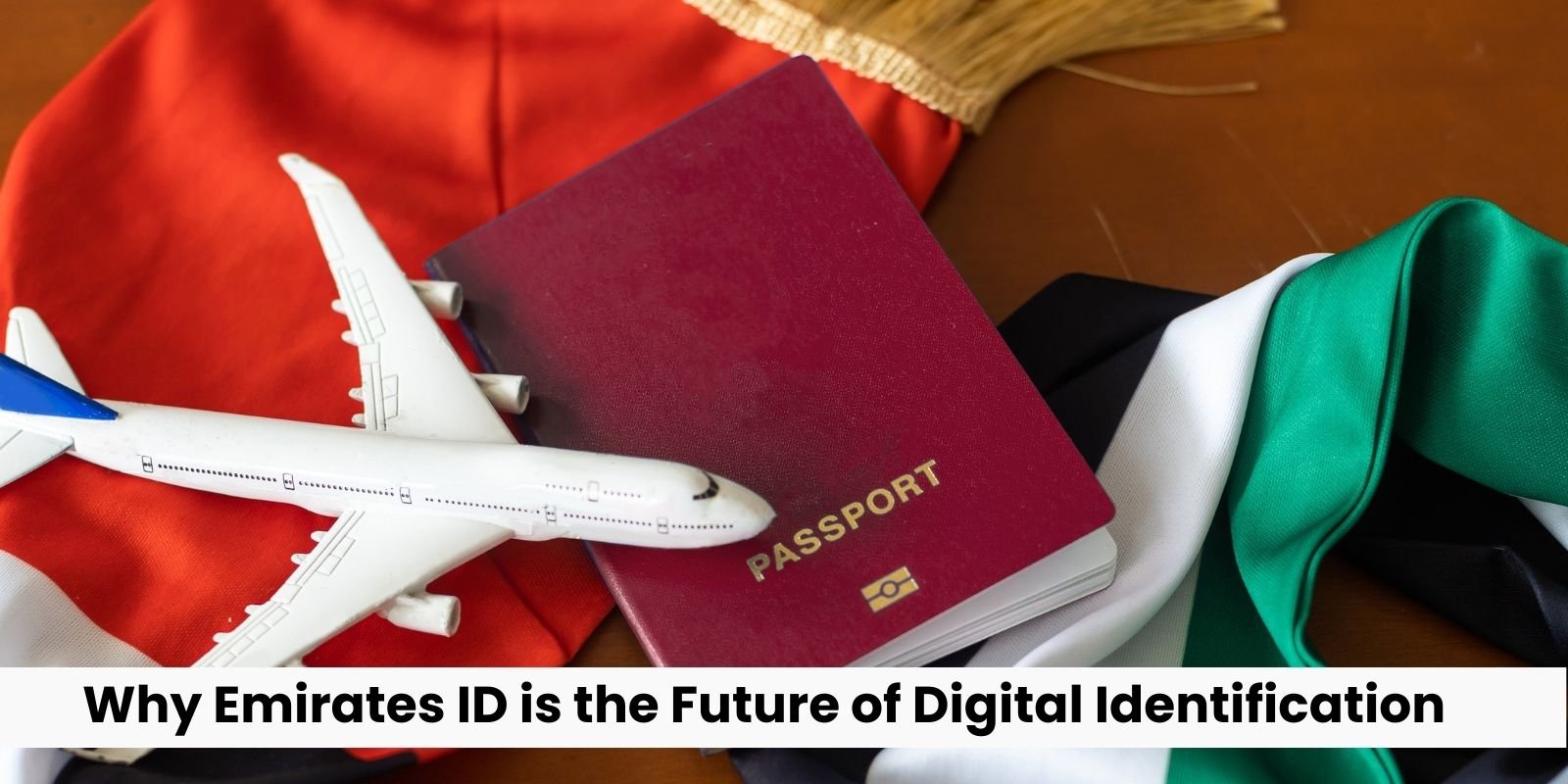Business
Why Emirates ID is the Future of Digital Identification ?

The need for secure and convenient identification has become paramount in the digital age, where transactions and interactions are increasingly conducted online. Traditional forms of identification, such as physical cards and documents, are often cumbersome and vulnerable to fraud. Recognizing this challenge, governments and organizations worldwide are turning to digital identification systems to streamline processes, enhance security, and improve user experience.
The Rise of Digital Identification
Digital identification, also known as eID, refers to the use of electronic credentials to verify individuals’ identities in online transactions and interactions. Unlike traditional forms of identification, such as passports and driver’s licenses, digital IDs are stored and transmitted electronically, typically in a secure digital format.
Several factors have driven the shift toward digital identification:
- Technological Advancements: The proliferation of biometric technology, encryption algorithms, and secure hardware has made it possible to create highly secure digital IDs.
- Increasing Digitization: With the growing prevalence of online services in areas such as banking, healthcare, and government, there is a greater need for reliable digital identification systems.
- Security Concerns: Traditional forms of identification are susceptible to theft, forgery, and tampering. To mitigate these risks, digital IDs offer enhanced security features, such as biometric authentication and cryptographic signatures.
- Convenience and Efficiency: Digital IDs can be accessed and verified quickly and easily, saving individuals and organizations time and resources.
Key Features of Digital Identification Systems
Digital identification systems come in various forms, but they typically share several key features:
- Biometric Authentication: Many digital ID systems incorporate biometric data, such as fingerprints or facial recognition, to verify the identity of users. This adds an extra layer of security beyond traditional forms of authentication, such as passwords or PINs.
- Cryptographic Signatures: Digital IDs often include cryptographic keys that allow users to sign documents and transactions electronically. These signatures are legally binding and provide higher security than handwritten signatures.
- Mobile Integration: With the widespread adoption of smartphones and mobile devices, many digital ID systems offer mobile apps that allow users to access and manage their IDs on the go.
- Interoperability: Digital IDs must be interoperable across different systems and platforms to be truly effective. This allows users to use their IDs seamlessly across a variety of services and applications.
Case Study: The Emirates ID
One notable example of a successful digital identification system is the Emirates ID, implemented by the United Arab Emirates (UAE). This comprehensive system has revolutionized the way individuals interact with government and private sector services in the UAE.
Applications of Emirates ID
The Emirates ID’s multifaceted capabilities open up a wide range of applications:
| Application | Description |
|---|---|
| E-Government Services | Effortless access to a plethora of governmental services and transactions. |
| Healthcare Management | Reliable patient identification for electronic health record management. |
| Airport and Travel Services | Efficient and safe travel across GCC countries facilitated by the Emirates ID. |
| Online Authentication | Legally accepted digital signatures for electronic document authentication. |
| Financial Transactions | Secure verification for banking and financial transactions. |
| Voting and Elections | Ensuring the authenticity of voters during elections. |
| Education and Academia | Simplified identification processes for educational institutions. |
Key features of the Emirates ID include:
- Biometric Authentication: The Emirates ID incorporates biometric data, such as fingerprints and retinal scans, to verify the identity of users, making it highly secure and resistant to fraud.
- Mobile Integration: Residents of the UAE can access their Emirates ID through a mobile app, allowing them to carry their digital identification wherever they go.
- Multi-Purpose Functionality: The Emirates ID serves as a key to a wide range of government and private sector services, including banking, healthcare, and education, streamlining processes and reducing the need for multiple forms of identification.
- Digital Signature Capability: The Emirates ID enables users to sign documents and transactions electronically, eliminating the need for physical signatures and printed copies.
Challenges and Considerations
While digital identification systems offer many benefits, they also pose several challenges and considerations:
- Privacy Concerns: Using biometric data raises privacy concerns about how this data is collected, stored, and used. Robust data protection regulations and user education are essential to address these concerns.
- Security Risks: Digital IDs are susceptible to hacking, identity theft, and other cybersecurity threats. Strong encryption and authentication measures are needed to protect against these risks.
- Interoperability: Achieving interoperability between digital ID systems is essential for seamless integration and widespread adoption. This requires cooperation and standardization among governments and organizations.
- Accessibility: Digital ID systems must be accessible to all individuals, regardless of their technological literacy or socioeconomic status. This may require providing alternative methods of authentication for those who do not have access to smartphones or computers.
Looking Ahead
Despite these challenges, the future of digital identification looks promising. As technology advances and governments and organizations prioritize security and convenience, digital IDs will likely become more widespread and sophisticated.
In conclusion, digital identification systems offer numerous benefits, including enhanced security, convenience, and efficiency. However, they also pose challenges that must be addressed to ensure their widespread adoption and success. By learning from case studies such as the Emirates ID and collaborating on standards and best practices, governments and organizations can harness the power of digital identification to create a more secure and connected world.
Accounting & Auditing
Top Strategies for Smart Real Estate Investment in Dubai
Top Strategies for Smart Real Estate Investment in Dubai
Investing in Dubai’s real estate market can be a lucrative venture, offering numerous opportunities for both locals and international investors. With its booming economy and strategic location, Dubai has positioned itself as a hub for cultural, business, and architectural marvels. This guide explores top strategies to improve your investment outcomes, focusing on diversification, leveraging crowdfunding platforms, and maximizing your returns.
Understanding the Market Landscape
Dubai’s real estate market is known for its rapid growth and diverse offerings. The sector encompasses various property types including residential, commercial, and industrial. For prospective investors, familiarizing oneself with the market dynamics is crucial. Key trends currently shaping the landscape include:
- Increased demand for luxury properties fueled by expatriate settlements.
- The ongoing development of free zones, offering tax advantages and enhancing investment appeal.
- The government’s focus on sustainability and smart cities, attracting a new wave of investors.
Understanding these aspects will help investors make informed decisions that align with their financial goals.
Diversification Strategy: Mitigating Risks
A successful investment strategy relies on diversification. By spreading your investments across various property types, you can minimize risks associated with market fluctuations. Here are key diversification tactics:
- Invest in Different Property Types: Consider a mix of residential, commercial, and industrial properties to balance potential risks and returns.
- Geographical Diversification: Invest in properties located in different areas of Dubai, such as Downtown, Dubai Marina, and emerging neighborhoods like Dubai Creek Harbour.
- Use Crowdfunding Platforms: Platforms like SmartCrowd allow investors to pool funds into larger properties, reducing individual risk while still offering access to high-quality investments.
This diversification not only helps stabilize your portfolio but also enhances the potential for passive income.
Leveraging Crowdfunding for Real Estate Investment
Real estate crowdfunding has emerged as a popular method for investors to enter the market without substantial upfront capital. This model offers a democratized approach to property investment, allowing individuals to contribute small amounts towards larger projects. The benefits of using a crowdfunding platform like SmartCrowd include:
- Low Minimum Investment: Investors can start with as little as AED 500, making it accessible to more people.
- Professional Management: Crowdfunding platforms typically manage the investments, taking away the stress of property management and allowing for a more hands-off approach.
- Portfolio Diversification: Investors can put money into multiple crowdfunding projects, spreading risk across different properties and locations.
This innovative funding model not only enhances liquidity in the market but also provides investors with the opportunity to earn high returns that traditional investing methods may not offer.
Understanding Returns and Investment Structures
High returns are often the main draw for real estate investment in Dubai. Understanding the different structures that define potential returns is essential:
- Rental Yields: Dubai’s rental market offers attractive yields, often ranging from 6% to 10% depending on the area and type of property.
- Capital Appreciation: Properties can appreciate significantly, especially in high-demand areas, enhancing the overall return on investment.
- Short-Term Rentals: Platforms like Airbnb enable property owners to earn income through short-term rentals, providing higher returns compared to traditional leasing.
These factors contribute significantly to the appeal of investing in Dubai real estate, highlighting the importance of strategic planning and market research.
Consideration of Regulatory Framework
Investors must navigate Dubai’s regulatory environment to ensure compliance and maximize their investment potential. Key regulations to be aware of include:
- Property Ownership Laws: Foreign ownership is allowed in designated areas, which is crucial for expatriate investors.
- Regulatory Bodies: The Dubai Land Department (DLD) and Real Estate Regulatory Agency (RERA) govern the market, providing guidelines for transparent property transactions.
- Legal Framework: It’s advisable to consult with legal experts familiar with Dubai’s property laws to avoid pitfalls and ensure a smooth investment process.
The understanding of regulations not only safeguards your investment but also builds credibility amongst local stakeholders.
Golden Visa and Long-term Investment Benefits
The UAE offers a Golden Visa program, which grants long-term residency to investors and their families who invest in real estate. This program is attractive for several reasons:
- Stability: Securing a Golden Visa provides a reliable residency option, making it easier for you and your family to live and work in Dubai.
- Access to Exclusive Opportunities: Golden Visa holders often have access to special investment opportunities in high-profile developments.
- Potential Tax Benefits: Investing through this program may offer favorable tax conditions, making your investment more lucrative.
By leveraging such initiatives, investors can not only increase their financial portfolios but also benefit from the lifestyle that Dubai offers.
Frequently Asked Questions about Real Estate Investment
Which real estate investment is best?
The best investment often depends on individual financial goals and risk tolerance. For long-term stability, residential properties can be ideal, while commercial properties might offer higher yields with more risk.
How to invest 2000 dirhams in the UAE?
With AED 2,000, consider participating in real estate crowdfunding platforms that allow for fractional investments in properties, providing an opportunity to earn passive income with a lower financial barrier.
What creates 90% of millionaires?
Real estate investment is a significant contributor to wealth creation, offering potential for capital appreciation and recurring income streams.
Can I invest $100 dollars in real estate?
While traditional real estate purchases require larger sums, crowdfunding platforms allow for investments starting from low amounts, making it accessible to those with limited capital.
Investing in Dubai’s real estate market presents a myriad of opportunities. By employing strategies such as diversification, utilizing crowdfunding platforms, and understanding market regulations, investors can position themselves for success in this dynamic landscape. For more insights, consider browsing our articles on starting a business in Dubai, or explore how to choose the best consultant for navigating the complexities of property investment.
Business
How to Start a Construction Company in Saudi Arabia: Your Comprehensive Guide
Starting a construction company in Saudi Arabia can be a lucrative endeavor. The kingdom is rapidly expanding, and with projects like Vision 2030, there is no shortage of opportunities in the construction sector. However, navigating the process can be daunting without proper guidance. This blog post aims to provide you with a detailed, human-centered guide to starting your construction company in Saudi Arabia, while also incorporating some key insights into business setups in Dubai.
1. Understanding the Market: Why Saudi Arabia?The Booming Construction Sector
Saudi Arabia’s construction sector is booming, thanks to mega-projects like NEOM, the Red Sea Project, and the expansion of Mecca. The government’s Vision 2030 plan aims to diversify the economy and reduce dependency on oil, leading to an influx of investments in infrastructure, tourism, and entertainment sectors. This means there is a substantial demand for construction services.
Strategic Geographical PositionSaudi Arabia’s strategic geographical position at the crossroads of Europe, Asia, and Africa makes it an attractive location for business. The kingdom serves as a gateway to other Middle Eastern countries, offering a broad market reach for your construction business.
2. Initial Planning: Setting the FoundationConducting Market ResearchBefore you dive into the construction business, thorough market research is crucial. Understand the current market trends, identify potential competitors, and gauge the demand for specific construction services. This research will help you make informed decisions and tailor your services to meet market needs.
Defining Your Business ScopeDetermine the scope of your construction company. Will you focus on residential buildings, commercial projects, or infrastructure development? Clearly defining your business scope will help streamline your operations and marketing strategies.
3. Legal Formalities: Navigating RegulationsBusiness Registration and LicensingThe first step in setting up your construction company is to register your business with the Saudi Arabian General Investment Authority (SAGIA). Ensure that you comply with all regulatory requirements, including obtaining necessary licenses for construction activities. This process involves submitting a detailed business plan, financial statements, and other relevant documents.
Understanding Saudi Labor LawsSaudi labor laws are stringent, and it’s essential to familiarize yourself with them. This includes understanding employment contracts, work permits for expatriates, and compliance with Saudization policies, which require a certain percentage of your workforce to be Saudi nationals.
4. Financial Planning: Securing Your FundsEstimating Startup CostsEstimating the initial investment required to start your construction company is crucial. This includes costs for business registration, licensing, office setup, equipment purchase, and hiring staff. Having a clear financial plan will help you manage your resources efficiently.
Exploring Funding OptionsExplore various funding options to secure the capital needed for your business. This could include personal savings, bank loans, or attracting investors. The Saudi government also offers financial support and incentives for businesses that align with Vision 2030.
5. Building Your Team: Recruiting the Right TalentHiring Skilled ProfessionalsYour construction company’s success largely depends on the skills and expertise of your team. Hire experienced professionals, including engineers, project managers, and skilled laborers. Ensure that your team is well-versed in modern construction techniques and safety protocols.
Training and DevelopmentInvest in training and development programs to enhance your team’s skills and keep them updated with the latest industry trends. This will not only improve the quality of your projects but also boost employee morale and retention.
6. Acquiring Equipment: Investing in the Right ToolsSelecting High-Quality EquipmentInvesting in high-quality construction equipment is essential for the efficient execution of projects. This includes machinery like excavators, cranes, and concrete mixers. Ensure that your equipment meets industry standards and is regularly maintained to avoid downtime.
Leasing vs. BuyingDecide whether to lease or buy construction equipment based on your financial situation and project requirements. Leasing can be a cost-effective option for short-term projects, while buying might be more economical for long-term use.
7. Marketing Your Business: Attracting ClientsCreating a Strong Brand IdentityBuilding a strong brand identity is crucial for attracting clients. Develop a professional logo, create a user-friendly website, and maintain a consistent brand image across all marketing channels. Highlight your expertise, successful projects, and client testimonials to build credibility.
Utilizing Digital MarketingLeverage digital marketing strategies to reach a wider audience. This includes search engine optimization (SEO), social media marketing, and content marketing. Utilize keywords like “business setup in Dubai,” “company registration in Dubai,” and “company formation in Dubai” to attract potential clients looking for construction services in the region.
8. Networking: Building Strong RelationshipsConnecting with Industry StakeholdersNetworking with industry stakeholders, including suppliers, subcontractors, and government officials, is essential for your construction business. Attend industry events, join construction associations, and participate in trade shows to build valuable connections.
Collaborating with Other BusinessesConsider collaborating with other businesses in the construction industry. This could include joint ventures, partnerships, or subcontracting agreements. Collaborations can help you expand your services, share resources, and increase your market reach.
9. Ensuring Compliance: Meeting Industry StandardsAdhering to Safety RegulationsSafety is paramount in the construction industry. Ensure that your company complies with all safety regulations and industry standards. This includes providing personal protective equipment (PPE) to workers, conducting regular safety training, and implementing safety protocols on-site.
Quality AssuranceImplement strict quality control measures to ensure that your projects meet the highest standards. This includes regular inspections, using high-quality materials, and adhering to project timelines. Delivering quality work will enhance your reputation and attract repeat business.
10. Expanding Your Business: Future GrowthExploring New MarketsOnce your construction company is established, consider expanding to new markets within Saudi Arabia or even internationally. Conduct market research to identify potential opportunities and develop a strategic plan for expansion.
Investing in TechnologyInvesting in modern construction technologies can give your business a competitive edge. This includes Building Information Modeling (BIM), drones for site inspections, and project management software. Embracing technology will improve efficiency, reduce costs, and enhance project outcomes.
11. Learning from Dubai: Business Setup InsightsComparing Business EnvironmentsWhile setting up a business in Saudi Arabia, it’s beneficial to learn from the business environment in Dubai. Dubai is known for its business-friendly policies, streamlined company registration processes, and low-cost business setup options. Understanding these aspects can provide valuable insights for your own business setup.
Incorporating Best PracticesIncorporate best practices from Dubai’s business setup process. This includes efficient company registration, leveraging free zones for tax benefits, and maintaining transparency in business operations. Adopting these practices can enhance your business setup experience in Saudi Arabia.
12. Final Thoughts: Your Path to SuccessStarting a construction company in Saudi Arabia requires careful planning, adherence to regulations, and strategic decision-making. By understanding the market, securing funding, building a skilled team, and leveraging marketing strategies, you can establish a successful construction business in the kingdom. Keep learning, adapting, and innovating to stay ahead in this dynamic industry. And remember, insights from other business hubs like Dubai can offer valuable lessons for your journey.With this comprehensive guide, you are now equipped with the knowledge and tools to start your construction company in Saudi Arabia. The kingdom’s booming construction sector, coupled with strategic planning and execution, can pave the way for your success. Best of luck on your entrepreneurial journey
Business
How to Open a Grocery Store in Dubai
Dubai is a global hub for commerce, tourism, and trade. With its growing population, multicultural environment, and a booming retail sector, opening a grocery store in Dubai can be a lucrative business venture. This blog will guide you through the steps to establish your Grocery store setup in Dubai, the costs involved, and essential factors to consider.
Benefits of Opening a Grocery Store in Dubai
A Thriving Retail Market
Dubai’s retail sector is one of the fastest-growing in the world, driven by its cosmopolitan population and high disposable income. The demand for daily essentials makes grocery stores an evergreen business opportunity. Moreover, with the government’s push for economic diversification, retail businesses, including grocery stores, are thriving.
- Dubai offers an excellent platform for entrepreneurs seeking retail business registration in Dubai, providing access to both local and international consumers.
- The city’s strategic location makes it easy to import high-quality goods, offering a competitive edge in the market.
Government Support for Entrepreneurs
The UAE government actively supports business owners by offering streamlined processes for obtaining a Dubai grocery store business license. Initiatives like reduced tax burdens and access to free zones make it easier to set up and grow your business.
- Setting up your Grocery store setup in Dubai comes with the added advantage of investor-friendly policies.
- Additionally, the rising popularity of online grocery delivery services opens avenues to diversify your offerings.
How To Start a Grocery Store in Dubai?
Starting a grocery store in Dubai involves a series of steps that ensure your business complies with local regulations while meeting market demands. Here’s how you can get started:
Choose the Right Business Structure
The first step in your business setup in Dubai is deciding whether to operate in a mainland area or a free zone. While free zones offer tax benefits, mainland registration allows you to cater to the local market.
- Mainland businesses require a local sponsor, who will own 51% of the business, while you retain full operational control.
- Alternatively, free zones like the Dubai Multi Commodities Centre (DMCC) offer 100% foreign ownership.
Obtain a Dubai Grocery Store Business License
Securing a Dubai grocery store business license is essential to operate legally. This involves:
- Registering your business name with the Department of Economic Development (DED).
- Submitting a detailed business plan outlining your store’s structure, operations, and revenue model.
Once approved, you will receive your license, allowing you to begin operations.
Location and Premises Selection
Selecting the right location is crucial for your Grocery store setup in Dubai. High foot traffic areas such as residential communities or commercial hubs are ideal. Ensure your premises meet the local municipality’s health and safety standards.
Cost of Starting a Grocery Store in Dubai
Key Expenses to Consider
The cost to open a grocery store in Dubai depends on several factors, including the size of your store, its location, and inventory requirements.
- Dubai grocery store business license fees: Expect to pay AED 10,000–15,000, depending on the nature of your license.
- Premises rental: Depending on the area, rental costs can range from AED 50,000 to over AED 200,000 annually.
Other Costs
- Initial setup fees: These include registration fees with the DED or free zone authorities, ranging between AED 5,000–10,000.
- Inventory costs: Stocking your store with essential items may require an initial investment of AED 30,000–50,000.
- Staffing: Salaries for staff and managers typically range between AED 2,000–5,000 per person, per month.
With proper planning, the cost to open a grocery store in Dubai can be optimized, ensuring you remain within budget while offering quality services.
Factors to Consider Before Starting a Grocery Store Business in Dubai
Market Research and Target Audience
Before embarking on your grocery business registration in Dubai, conduct thorough market research to understand consumer needs, competition, and market trends.
- Identify the products that are in high demand among Dubai’s diverse population.
- Assess competition in your chosen area to position your store effectively.
Legal and Regulatory Compliance
Dubai has strict regulations for the food and beverage industry, which you must adhere to.
- Ensure your store meets Dubai Municipality guidelines for food storage and safety.
- Regular inspections may be conducted, so maintaining high standards is essential for long-term success.
3. Technology and Online Presence
Incorporating technology can give your Grocery store setup in Dubai a competitive edge.
- Consider launching an online grocery delivery service to reach tech-savvy customers.
- Use inventory management software to streamline operations and reduce costs.
Additional Tips for Success
Build Strong Supplier Relationships
Partnering with reliable suppliers ensures consistent quality and availability of products. Dubai’s proximity to international trade routes makes it easier to import goods at competitive prices.
Offer Excellent Customer Service
Exceptional customer service can set your store apart from competitors. Train your staff to be courteous, knowledgeable, and efficient.
Starting a grocery store in Dubai offers immense potential for growth and profitability. By understanding the process, managing costs effectively, and adhering to local regulations, you can establish a successful business in this vibrant city. Whether you aim to operate a small neighborhood store or a large supermarket, Dubai provides a dynamic and supportive environment for retail entrepreneurs.
Requirements to Open a Grocery Store in Dubai
Opening a grocery store in Dubai involves meeting specific legal, operational, and logistical requirements to ensure compliance with local regulations. Here’s a detailed breakdown of what you need:
1. Business License
Obtaining a Dubai grocery store business license from the Department of Economic Development (DED) is mandatory. The process involves:
- Choosing a trade name and getting it approved.
- Submitting a business plan and application for license issuance.
- Paying the required licensing fees.
2. Approvals and Permits
Additional permits from relevant authorities may be needed based on the nature of your store.
- Food safety approvals from the Dubai Municipality.
- Health and hygiene inspections for the premises.
3. Business Setup Essentials
Before you start operations, you need to fulfill basic setup requirements:
- Renting a suitable location that complies with zoning regulations.
- Acquiring equipment like shelves, refrigeration units, and point-of-sale systems.
4. Staffing Requirements
Hiring trained personnel to manage store operations, customer service, and inventory is crucial. Ensure all staff possess valid work permits.
5. Financial Planning
Proper budgeting is critical to cover the cost to open a grocery store in Dubai, including:
- Inventory procurement.
- Operational expenses like rent, salaries, and utilities.
6. Compliance with Retail Laws
Adhering to retail laws is essential for a successful Grocery store setup in Dubai. This includes:
- Displaying clear pricing and ensuring accurate billing.
- Complying with consumer protection laws.
Meeting these requirements ensures a seamless setup and smooth operation of your grocery store, positioning you for long-term success in Dubai’s thriving retail market.
Frequently Asked Questions (FAQs)
1. What are the key steps for Grocery Store Setup in Dubai?
To set up a grocery store in Dubai:
- Choose a business structure (mainland or free zone).
- Register your trade name with the Department of Economic Development (DED).
- Obtain a Dubai grocery store business license.
- Secure a commercial space in a strategic location.
- Comply with food safety and hygiene regulations.
2. How much does it cost to open a grocery store in Dubai?
The cost to open a grocery store in Dubai varies based on factors like location, store size, and initial inventory. Key costs include:
- Licensing and registration fees: AED 10,000–20,000.
- Rent: AED 50,000–200,000 annually, depending on the location.
- Inventory and equipment: AED 30,000–70,000.
3. Do I need special permits to operate a grocery store in Dubai?
Yes, grocery store operations require:
- A Dubai grocery store business license issued by the DED.
- Food safety approvals and permits from the Dubai Municipality.
4. Can a grocery store be set up in a Dubai free zone?
Yes, you can set up a grocery store in a free zone. However, selling directly to the local market may require additional permissions or partnerships with local distributors.
5. What factors affect the success of a grocery store in Dubai?
Success depends on:
- Strategic location with high foot traffic.
- Competitive pricing and product variety.
- Effective marketing strategies, including online grocery delivery services.
6. Are there specific laws to follow for grocery store operations?
Yes, grocery store owners must comply with:
- Consumer protection laws, including clear pricing and accurate billing.
- Food safety regulations for storage and handling.
- Regular inspections by Dubai Municipality.
7. Can I expand my grocery store with online services?
Absolutely! Adding an online grocery delivery service can significantly boost your business. Many customers in Dubai prefer the convenience of shopping online.
-

 Business2 years ago
Business2 years agoTop 10 Highest-Paying Jobs in Dubai for 2024-25
-

 Business2 years ago
Business2 years agoTop 10 Business Opportunities in Dubai for 2024-2025
-

 Business2 years ago
Business2 years agoBest upcoming exhibitions and trade shows in Dubai, 2024
-

 Business1 year ago
Business1 year agoHow Much Does It Cost to Open a Company in Dubai in 2024?
-

 Sports2 years ago
Sports2 years agoTop 5 Upcoming International Sporting Events in Dubai (2024-2025)
-

 Blog2 years ago
Blog2 years agoPlaces to Visit in Ras Al Khaimah
-

 Business2 years ago
Business2 years agoTop 5 Networking Events for Businesses in Dubai in 2024
-

 Latest3 months ago
Latest3 months agoDubai Golden Visa 2025: Everything You Need to Know About Eligibility, Benefits and Application Process



